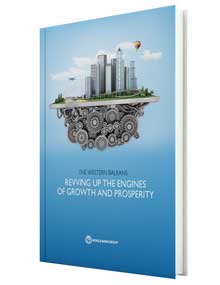 The Western Balkans: Revving Up the Engines of Growth and Prosperity
The Western Balkans: Revving Up the Engines of Growth and Prosperity

The six Western Balkan countries (WB6) have already achieved strong growth and poverty reduction. The period of 1995-2015 saw living standards increase (from a low base) almost six-fold in Bosnia and Herzegovina, nearly triple in Albania, and almost double in Serbia. But some of the neighboring countries did better.
Dramatic differences in growth trends and in convergence to higher income levels are notable in the region before and after the global financial crisis. At a 5.6 percent average during 2000-08, living standards in the WB6 were rising faster than world and EU averages, lagging only slightly behind the other small transition economies that are now in the EU. The growth also helped drive down poverty in most of the Western Balkan countries.
In the early 2000s, roughly one in three people in the region lived on less than $5 per day. In 2008, only about one in five did. High structural unemployment, a legacy of Yugoslavia, improved somewhat during this period. Moreover, the Human Development Index—which aggregates key dimensions of human development such as a long and healthy life, being knowledgeable, and having a decent standard of living—increased over this same period in the Western Balkans and is higher than in other countries with similar income.
After the global crisis in 2008, growth slowed precipitously, although it remained higher than the average in Europe. Unemployment has remained persistently high: in 2015, seven years after the start of the global financial crisis, it ranged between 17 and 33 percent, with youth unemployment almost double the average.
Levels of emigration from the Western Balkans are high as young and educated people look for opportunities elsewhere. Today, the six countries remain among the poorest in Europe, with lower standards of living on display in everyday life.
Despite these realities, the Western Balkan economies have significant potential for growth. They are located next door to the huge EU market and have made some progress in integrating their economies into world markets in such fields as finance and trade.
The Western Balkan countries could grow by exploiting these potentials. The challenges posed by the aging of their populations add further urgency. Deeper reforms would also serve to accelerate the EU accession process, which provides the strongest anchor for reform.
In the early 2000s, roughly one in three people in the region lived on less than $5 per day. In 2008, only about one in five did. High structural unemployment, a legacy of Yugoslavia, improved somewhat during this period. Moreover, the Human Development Index—which aggregates key dimensions of human development such as a long and healthy life, being knowledgeable, and having a decent standard of living—increased over this same period in the Western Balkans and is higher than in other countries with similar income.
After the global crisis in 2008, growth slowed precipitously, although it remained higher than the average in Europe. Unemployment has remained persistently high: in 2015, seven years after the start of the global financial crisis, it ranged between 17 and 33 percent, with youth unemployment almost double the average. Levels of emigration from the Western Balkans are high as young and educated people look for opportunities elsewhere. Today, the six countries remain among the poorest in Europe, with lower standards of living on display in everyday life.
Despite these realities, the Western Balkan economies have significant potential for growth. They are located next door to the huge EU market and have made some progress in integrating their economies into world markets in such fields as finance and trade.
The Western Balkan countries could grow by exploiting these potentials. The challenges posed by the aging of their populations add further urgency. Deeper reforms would also serve to accelerate the EU accession process, which provides the strongest anchor for reform.
In the early 2000s, roughly one in three people in the region lived on less than $5 per day. In 2008, only about one in five did. High structural unemployment, a legacy of Yugoslavia, improved somewhat during this period. Moreover, the Human Development Index—which aggregates key dimensions of human development such as a long and healthy life, being knowledgeable, and having a decent standard of living—increased over this same period in the Western Balkans and is higher than in other countries with similar income.
After the global crisis in 2008, growth slowed precipitously, although it remained higher than the average in Europe. Unemployment has remained persistently high: in 2015, seven years after the start of the global financial crisis, it ranged between 17 and 33 percent, with youth unemployment almost double the average. Levels of emigration from the Western Balkans are high as young and educated people look for opportunities elsewhere. Today, the six countries remain among the poorest in Europe, with lower standards of living on display in everyday life.
Despite these realities, the Western Balkan economies have significant potential for growth. They are located next door to the huge EU market and have made some progress in integrating their economies into world markets in such fields as finance and trade.
The Western Balkan countries could grow by exploiting these potentials. The challenges posed by the aging of their populations add further urgency. Deeper reforms would also serve to accelerate the EU accession process, which provides the strongest anchor for reform.